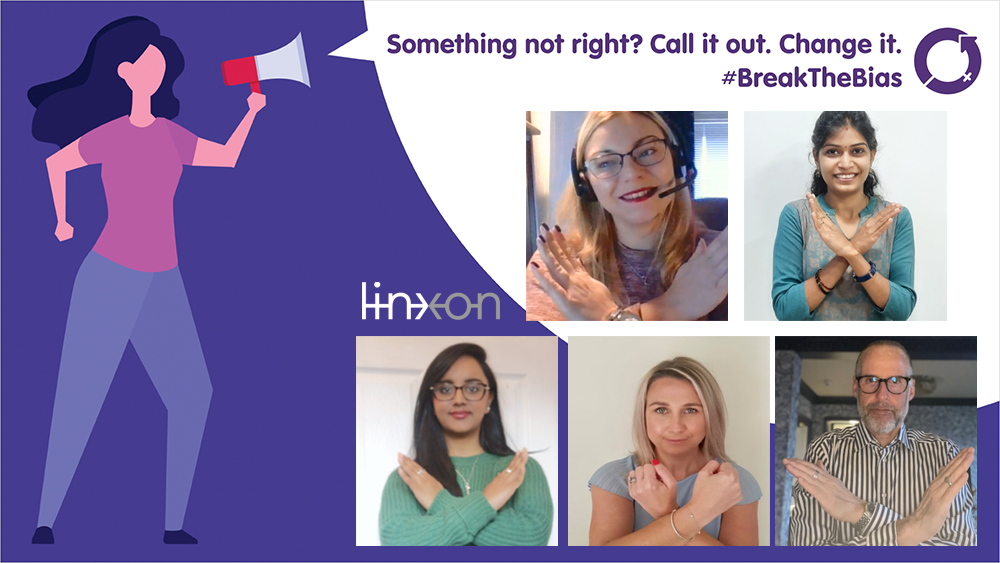#BreakTheBias and set new examples!
March 8, 2022
Imagine a world free of prejudice and stereotypes, one that is diverse, equitable and inclusive. That’s the idea behind International Women’s Day 2022, held on 8 March, and its theme #BreakTheBias. At Linxon, we provide an environment where everyone can contribute, irrespective of gender and background. Here, our female employees talk about their experiences with bias and how we are working to overcome it. Also the CEO of Linxon, Stefan Reisacher, is sharing his toughts.
“I want to see more female employees contributing a different approach, which is a real necessity right now. With an inclusive culture come better business opportunities, growth and success for our organization,”
says Nisha Jasani, Senior Project Engineer at Linxon India.
It’s well documented that greater diversity leads to more creativity, innovation and also profitability.
And when it comes to engineering, the World Economic Forum adds: “Attracting and supporting more women in engineering benefits everyone by increasing the potential to develop inclusive, innovative solutions for the complex problems the world is facing.”
One of the biggest global challenges right now is climate change, and at Linxon we are helping combat this via our mission of shaping energy solutions to empower sustainable connectivity. “We need technology experts to make this happen,” explains Stefan Reisacher, Linxon CEO, “and we’re already facing a shortage of talent. So why should 50% of the workforce face barriers to taking tech roles? At Linxon, we’re doing the opposite: offering equal opportunities irrespective of gender. And, beyond that, we’re creating an environment where everyone is encouraged to contribute.”
We’re still not there… but we’re working on it
Only 14.5% of those working in engineering are female, according to EngineeringUK analysis from 2020 – although this figure has risen from the 12% reported in 2018. Despite the rise, women are still significantly underrepresented in this profession – which is why it’s so important to create a workplace without bias as well as increase the visibility of female role models.
Stacey Williams is Supply Chain Manager for Linxon UK. She looks forward to seeing significant movements in the gender gap within the engineering and construction industry, and is proud to be a role model to her 13-year-old daughter. During lockdown, her daughter witnessed first hand how she juggled multiple roles – “working full time, mum, chef, cleaner, teacher (to name just a few!),” she says, adding that: “It’s my responsibility to ensure that I am a role model, demonstrating that through hard work and dedication, she is not limited by her gender.”
Stacey also believes that “Linxon’s core value is its people, not only making the investment in the people of ‘now’ but also that of the next generation.” To do this, for example, we are leading the way in STEM initiatives, taking part in outreach activities with students, and launching graduation schemes. Linxon’s Global Head of HR, Cathy Carolan – who’s a working mum with two daughters – agrees with Stacey’s words and aims to see business creating more opportunities for underrepresented groups. “We need to invest in training and education to promote our industry so that we are proactive in building talent pipelines for the future,” she adds.
Cathy also explains that this year Linxon will have a focus on equality, diversity and inclusion (ED&I) as part of our business strategy. More specifically, our ED&I aims for the coming years are to:
- remove all barriers
- embed ED&I into our culture just as Health & Safety and integrity are
- ensure all staff are confident in raising ED&I issues
- be a respected voice both inside and outside of our sector to accelerate change
“This doesn’t start and end with gender diversity,” Stefan underlines.
“We’re devoted to developing the diversity of our teams, promoting an inclusive culture, and providing everyone with an equal voice.”
Seeing changes in a post-pandemic world
Another positive step towards greater gender diversity is appointing higher numbers of women to decision-making levels. A found that having a critical mass of more than 30% women on boards makes for better climate governance and innovation. The study also found that there had been an eightfold increase in the share of companies with more than 30% women on their boards over the preceding decade (from 2% to 16%).
This reflects the structure of Linxon’s management team, as women make up one third of its membership. And when it comes to overall hires, around 20% of newcomers are female employees.
As Linxon works to ensure equal opportunities for all, it is focusing on allowing greater flexibility in the workplace. Covid-19 has accelerated the pace of workplace change, proving that hybrid working practices are possible, Linxon will continue its drive towards becoming more accommodating to family life and work/life balance to attract and retain key talent. “The gift of time is such a significant benefit to any working mum and Linxon has really embraced the post-Covid working world,” Cathy explains.
Stacey also appreciates the flexibility of Linxon’s working from home agreement, and her colleague Rukhsaar Hussain, HR Operations Specialist at Linxon UK, agrees. “Linxon is very accommodating to all employees and a lot more flexible than other places I have worked at,” she says. “I appreciate being able to manage my life at work and home equally.”
So, how can we #BreakTheBias?
All these measures – more board representation, female role models, STEM outreach and policies to encourage work/life balance – are indeed great steps on the path towards equal representation and breaking down discrimination.
The majority of female colleagues have experienced gender bias in the workplace, with Stacey and Rukhsaar mentioning occasions when they were the only woman in the room, comments on their appearance or approachability, or not being listened to despite being more knowledgeable on the topic than their male colleagues. Stacey has also often been addressed as “William”, with suppliers assuming she is a man due to her role – until they see each other on a video call!
So, what can be done? As Stacey says, “The first step is to acknowledge that unconscious bias exists and that we all have pre-conceptions about people. Stereotypes, representation and unconscious gender bias has been handled very well so far within Linxon, and the ED&I workshops have been most beneficial in ‘breaking the bias’.”
Cathy and Nisha underline that the power to bring about change is in our own hands. “Breaking the bias is all of our responsibility,” says Cathy, “and we all need to call out behaviours that do not align to our values.” And Nisha, who has also juggled multiple family roles alongside her professional role, concludes: “It becomes too challenging when you wish to be perfect in all roles. I realized you cannot be omnipresent and should just be the best at what you can do. And then grab the opportunities provided to you and climb the ladder of success – this will indirectly break the bias and set new examples!”






